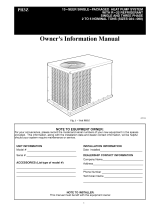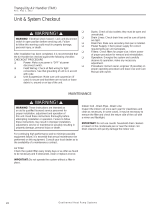
12
CAUTION:
To avoid personal injury or property damage,
make sure the motor leads do not come into
contact with any uninsulated metal components
of the unit.
For optimum system performance and comfort, it may be
necessary to change the factory set speed. See Table 5,
(page 16) for airflow data. To change the blower speed:
1. Disconnect all electrical power to the unit and remove
the upper door.
2. Remove the black and red wires from the blower motor
jumping terminal. Discard the blower motor jumping
terminal.
3. Connect the heating speed wire (red) and the cooling
speed wire (black) to the desired blower speed marked
on the terminal block of the blower motor.
• Terminal4=Hispeed
• Terminal5=Medspeed
• Terminal6=Lowspeed
4. Replace the upper door and secure it to the unit.
5. Restore power to the unit.
High Efficiency Units (Variable & Fixed Speed)
IMPORTANT! This air handler has been designed to
give the installer maximum flexibility to optimize system
performance, efficiency, and comfort. Because there
are so many different ways to set up the air handler it is
important to read and follow these directions carefully.
MB7EM & MB7VM air handlers use high efficiency
circulating air motors that come in two variations and both
are controlled differently. The fixed speed motor control
board (Figure 13 (page 25)) controls the torque and
the variable speed motor control board (Figure 14 (page
25)) controls the airflow at a constant CFM. The variable
speed control board requires a second control board.
Before operation, the air handler must be configured
to match the unit with the system, system options, and
climatic conditions. During normal operation, the motor
will gradually change speeds during start-up, shut down,
when thermostat inputs change, and when the duct static
pressure changes (vents closed or opened, filter clogging,
etc.). The air handler is configured by setting the selector
switches and removing jumper connectors.
Selecting Basic Heating Airflow
Fixed & variable speed motor control boards (Figure 13
& Figure 14) contain a set of dip switches for setting the
blower speed. For MB7EM models, pins 1-4 set the speed
for heating. For MB7VM models, the A/B switch must be
set for the appropriate cabinet size (either setting can be
used for C-size cabinets). The airflow is set automatically
based on the amount of installed heat. For both MB7EM
& MB7VM models, the cooling speed is selected via
switches 5,6,7,& 8. To determine the appropriate switch
settings for your installation, see Table 6, Table 7, Table
8, & Table 9.
Selecting Basic Cooling / Heat Pump Airflow
The basic cooling/heat-pump airflow is controlled by setting
switches 5 - 8 on the motor control board (mounted on the
blower). All airflows for other modes of operation (except
electric heat) are determined by this basic setting. FAN
ONLY would deliver 50% of the selected cooling airflow.
Table 8 lists the basic airflow values recommended for each
nominal system capacity. To determine dip switch settings,
refer to Table 6, (page 17) for FSHE applications and
Table 9, (page 19) for VSHE applications.
• When operating in the heat pump mode, a higher
basic airflow setting will increase the energy efficiency
and capacity but will also decrease the supply air
temperature.
• For maximum capacity and energy efficiency, select an
airflow at or near the top of the range for that nominal
capacity. See Table 8.
• For maximum dehumidification, select an airflow near the
middle or bottom of the range for that nominal capacity.
Additional information on humidity control can be found
in the Humidistat and Delay Setting sections.
• For thermostats with a dehumidifier output, use a field
supplied wire to connect the thermostat’s dehumidifier
output to the terminal marked DHUM. The thermostat
should be set so that the DHUM output should be high
(energized) when dehumidification is needed. See also
Dehumidification Options section.
IMPORTANT! If coil icing is observed, the basic cooling/
heat-pump airflow selected may be too low. Verify the
setting selected is within the range shown in Table 8 and
that the the system is properly charged. Please refer to the
instructions supplied with the outdoor unit. If icing continues
to occur, raise the selected airflow one or two steps.
NOTE: Variable speed air handlers with SEER ratings
higher than 15 are matched with a 2-stage cooling outdoor
unit. They are programmed to operate at 75% of the
selected airflow while the system is in the lo-cool mode
and 100% of the selected airflow while in hi-cool mode.
Units with an FSHE control scheme (B6EM and 5 ton B6BM
units) have a control board that includes a 7 segment display to
help the installer identify what mode the air handler is running in
as well as troubleshooting if the unit is not functioning properly.
Table 2 contains a list of the codes that may appear on the 7
segment display. The display code will only show what mode the
air handler is currently in. There is not a history of fault codes
that have occurred in previous operation.
TROUBLESHOOTING
If the air handler fails to operate, check the following:
• Istheelectricturnedon?
• Isthethermostatoperatingproperly?
• Aretheblowercompartmentdoor(s)inplace?
• Istheairhandlerdisconnectclosed?
• Hasthecircuitbreakertrippedorthecontrolboardfuse
burnedopen?
• Areanymanualresetswitchesopen?
• Isthelterdirtyorplugged?
• IstheLEDonbothcontrolboardsconstantlyON?Ifnot,
refer to Table 3 or Table 4 to determine fault condition.





















